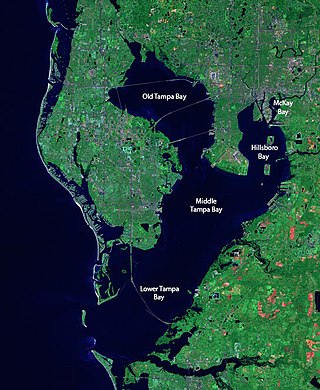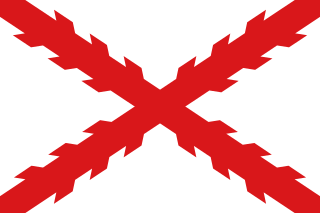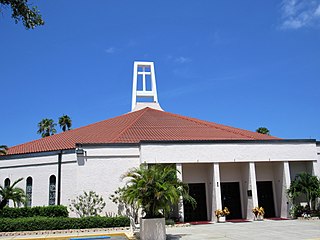
Pedro Menéndez de Avilés was a Spanish admiral, explorer and conquistador from Avilés, Asturias. He is notable for planning the first Spanish treasure fleet and founding St. Augustine, Florida, in 1565. This was the first successful European settlement in Spanish Florida and the most significant city in the region for nearly three centuries.

Tampa Bay is a large natural harbor and shallow estuary connected to the Gulf of Mexico on the west-central coast of Florida, comprising Hillsborough Bay, McKay Bay, Old Tampa Bay, Middle Tampa Bay, and Lower Tampa Bay. The largest freshwater inflow into the bay is the Hillsborough River, which flows into Hillsborough Bay in downtown Tampa. Many other smaller rivers and streams also flow into Tampa Bay, resulting in a large watershed area.

Pánfilo de Narváez was a Spanish conquistador and soldier in the Americas. Born in Spain, he first sailed to the island of Jamaica in 1510 as a soldier. Pánfilo participated in the conquest of Cuba and led an expedition to Camagüey, escorting Bartolomé de las Casas.

The Narváez expedition was a Spanish expedition started in 1527 that was intended to explore Florida and establish colonial settlements. The expedition was initially led by Pánfilo de Narváez, who died in 1528. Many more people died as the expedition traveled west along the explored Gulf Coast of the present-day United States and into the American southwest. Only four of the expedition's original members survived, reaching Mexico City in 1536. These survivors were the first known non-Native Americans to see the Mississippi River, and to cross the Gulf of Mexico and Texas.

The Apalachee were an Indigenous people of the Southeastern Woodlands, specifically an Indigenous people of Florida, who lived in the Florida Panhandle until the early 18th century. They lived between the Aucilla River and Ochlockonee River, at the head of Apalachee Bay, an area known as the Apalachee Province. They spoke a Muskogean language called Apalachee, which is now extinct.
Tocobaga was the name of a chiefdom of Native Americans, its chief, and its principal town during the 16th century. The chiefdom was centered around the northern end of Old Tampa Bay, the arm of Tampa Bay that extends between the present-day city of Tampa and northern Pinellas County. The exact location of the principal town is believed to be the archeological Safety Harbor site. This is the namesake for the Safety Harbor culture, of which the Tocobaga are the most well-known group.
Hernando de Escalante Fontaneda was a Spanish shipwreck survivor who lived among the Native Americans of Florida for 17 years. His c. 1575 memoir, Memoria de las cosas y costa y indios de la Florida, is one of the most valuable contemporary accounts of American Indian life from that period. The manuscript can be found in the General Archive of the Indies. In all, he produced five documents describing the peoples of native Florida.
Villa Canales is a city and municipality in the Guatemala department of Guatemala, situated 22 km south of the capital Guatemala City. As of the 2018 census, the city had a population of 124,680, making it the eleventh largest city in Guatemala.

Spanish Florida was the first major European land-claim and attempted settlement-area in northern America during the European Age of Discovery. La Florida formed part of the Captaincy General of Cuba, the Viceroyalty of New Spain, and the Spanish Empire during Spanish colonization of the Americas. While its boundaries were never clearly or formally defined, the territory was initially much larger than the present-day state of Florida, extending over much of what is now the southeastern United States, including all of present-day Florida plus portions of Georgia, South Carolina, North Carolina, Alabama, Mississippi, and the Florida Parishes of Louisiana. Spain based its claim to this vast area on several wide-ranging expeditions mounted during the 16th century. A number of missions, settlements, and small forts existed in the 16th and to a lesser extent in the 17th century; they were eventually abandoned due to pressure from the expanding English and French colonial settlements, the collapse of the native populations, and the general difficulty in becoming agriculturally or economically self-sufficient. By the 18th century, Spain's control over La Florida did not extend much beyond a handful of forts near St. Augustine, St. Marks, and Pensacola, all within the boundaries of present-day Florida.

The Diocese of Venice in Florida is a Latin Church ecclesiastical territory–or diocese, of the Catholic Church in southwest Florida in the United States. It was founded on June 16, 1984.

The Diocese of Saint Petersburg is a Latin Church ecclesiastical territory or diocese of the Catholic Church in the Tampa Bay region of Gulf Coast Florida.

Timeline of Pinellas County, Florida history.

The Alafia River is 25 miles (40 km) long, with a watershed of 335 square miles (870 km2) in Hillsborough County, Florida, United States, flowing into Tampa Bay. The watershed contains ten named lakes and ponds, and 29 named rivers, streams and canals. During the rainy season, excess water is pumped to the new C.W. Bill Young Regional Reservoir, which opened in 2005. The river is formed by two prongs. The north prong starts south of Mulberry and runs for 23.9 miles until it meets the south prong in Lithia. The south prong begins south of Bradley Junction and continues for 28.7 miles. The combined river then flows 24.7 miles west into Tampa Bay.

The Ajacán Mission was a Spanish attempt in 1570 to establish a Jesuit mission in the vicinity of the Virginia Peninsula to bring Christianity to the Virginia Native Americans. The effort to found St. Mary's Mission predated the founding of the English settlement at Jamestown, Virginia, by about 36 years. In February 1571, the entire party was massacred by Indians, except for Alonso de Olmos. The following year, a Spanish party from Florida went to the area, rescued Alonso, and killed several Indians.
Don Luís de Velasco, also known as Paquiquino, and also simply Don Luis, was a Native American, possibly of the Kiskiack or Paspahegh people, from the area of what is now Tidewater, Virginia. In 1561 he was taken by a Spanish expedition. He traveled with them ultimately to Spain, Cuba, and Mexico where he was baptized as "Luís de Velasco" and educated. Don Luís returned to Virginia in 1571 as guide and interpreter for a party of Jesuit missionaries. He is believed to have taken part in a later massacre of the Jesuits at this site, when the region was struggling with famine.

Beginning in the second half of the 16th century, the Kingdom of Spain established a number of missions throughout Spanish Florida in order to convert the Native Americans to Roman Catholicism, to facilitate control of the area, and to obstruct regional colonization by other Protestants, particularly, those from England and France. Spanish Florida originally included much of what is now the Southeastern United States, although Spain never exercised long-term effective control over more than the northern part of what is now the State of Florida from present-day St. Augustine to the area around Tallahassee, southeastern Georgia, and some coastal settlements, such as Pensacola, Florida. A few short-lived missions were established in other locations, including Mission Santa Elena in present-day South Carolina, around the Florida peninsula, and in the interior of Georgia and Alabama.

Sacred Heart Catholic Church was constructed in 1905 in downtown Tampa, Florida and is one of the oldest churches in the city of Tampa. The church, located at 509 N. Florida Avenue, is predominantly a Romanesque structure, with other elements. The church is home to Sacred Heart Parish, part of the West Hillsborough Deanery of the Roman Catholic Diocese of Saint Petersburg.

The Safety Harbor culture was an archaeological culture practiced by Native Americans living on the central Gulf coast of the Florida peninsula, from about 900 CE until after 1700. The Safety Harbor culture is defined by the presence of Safety Harbor ceramics in burial mounds. The culture is named after the Safety Harbor site, located close to the center of the culture area. The Safety Harbor site is the probable location of the chief town of the Tocobaga, the best known of the groups practicing the Safety Harbor culture.

This is a timeline of the U.S. state of Florida.

The Martyrs of La Florida were a group of Native American and Spanish Catholics killed in Florida during the Spanish Empire's colonial expansion into North America. The group of 86 individuals includes a number of priests and laypeople, killed by Native Americans and subjects of the British Empire. The lead martyr of the cause is the Native American layman Antonio Cuipa. Fr Luis Cáncer, OP is among the others killed, alongside a number of Dominicans, Jesuits, Franciscans, and various laypeople.














